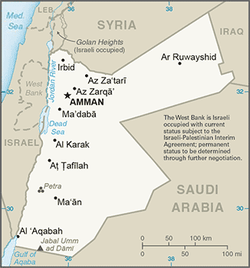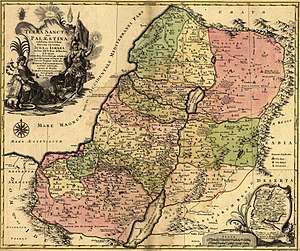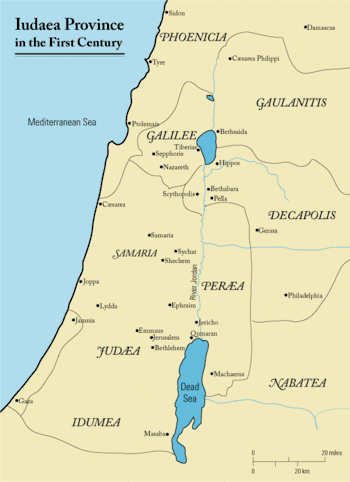History of the Jews in Jordan
The history of the Jews in Jordan can be traced back to Biblical times. Presently, there are no legal restrictions on Jews in Jordan, and they are permitted to own property and conduct business in the country, but in 2006 there were reported to be no Jewish citizens of Jordan,[1] nor any synagogues or other Jewish institutions.

Israelite tribes

According to the Hebrew Bible, three of the ancient Israelites tribes were allocated lands on the east side of the Jordan River valley, in the territory of present-day Jordan. They were the tribes of Reuben, Gad and Manasseh.[2] These tribes were members of the Northern Kingdom of Israel until the kingdom was conquered by Assyria in c. 723 BCE and the population deported.
A nation related to the Israelites, the Edomites (Idumaeans) resided in present-day southern Jordan, between the Dead Sea and the Gulf of Aqaba.

The Hasmonean official Antipater the Idumaean was of Idumean origin. He was the progenitor of the Herodian Dynasty that ruled Judea after the Roman conquest. When Herod the Great became king, Idumaea was ruled for him by a series of governors, among whom were his brother Joseph Antipater and his brother-in-law Costobarus.
Immediately before the siege of Jerusalem by Titus, 20,000 Idumaeans, under the leadership of John, Simeon, Phinehas, and Jacob, appeared before Jerusalem to fight on behalf of the Zealots who were besieged in the Second Temple.[3]
After the Jewish-Roman wars, the Idumaean people ceased to be mentioned in history.
Roman era
Roman rule in the region began in 63 BCE, when the general Pompey declared Judea a Roman protectorate. Over the years, Roman power over the Judean kingdom increased. Among the voices of opposition were John the Baptist, whose severed head was allegedly presented at the fortress of Machaerus to Herod. In 66 CE, the forces behind the First Jewish Revolt took control of Machaerus, and held it until 72 CE, when a siege secured the defeat of local Jewish forces.
At the end of the Bar Kochba revolt of 132-135 CE and the destruction of Judea, the Romans joined the province of Judea (which already included Samaria) to Galilee to form a new province, which they called Syria Palaestina.[4] Following the Roman conquest, the lands on both sides of the Jordan River with its Jewish inhabitants came under the control and decrees of subsequent Roman emperors and Arab caliphates.
Over the centuries, the Jewish population within present-day Jordan gradually declined, until no Jews were left.
British Empire
The British Balfour Declaration of 1917 endorsed the idea of a Jewish homeland in Palestine. The World Zionist Organization submitted to the Paris Peace conference of 1919 a memorandum specifying boundaries of Palestine, to be put under British Mandate and eventually to become an "autonomous Commonwealth". According to the document:
"The fertile plains east of the Jordan, since the earliest Biblical times, have been linked economically and politically with the land west of the Jordan. The country which is now very sparsely populated, in Roman times supported a great population. It could now serve admirably for colonisation on a large scale. A just regard for the economic needs of Palestine and Arabia demands that free access to the Hedjaz Railway throughout its length be accorded both Governments."[5]
From as early as 1917, the land to the east of the Jordan River, known as Transjordan, was treated separately by the British administration, who saw it as a separate future state.[6] A formal decision to restrict the Jewish homeland to west of the Jordan was made at the Cairo conference in March 1921, and accordingly a new article was added to the draft mandate text allowing the British government to administer Transjordan separately.[6] The mandate was approved by the League of Nations in July 1922, and in September 1922 the League approved a memorandum spelling out in detail the exclusion of Transjordan from the Jewish homeland provisions.[6]
In 1927, Pinchas Rutenberg, founder of the Palestine Electric Company, signed an agreement with King Abdullah I of Jordan to build a hydroelectric power station on the territory of Transjordanian Emirate. Construction of the Naharayim hydroelectric power plant began in 1928.[7] Tel Or was built near the power plant to house the permanent employees and their families. Tel Or was settled in 1930 and was the only Jewish village in Transjordan at the time. Residents also farmed thousands of dunams of land and sold some of the produce at a company workers’ supermarket in Haifa. The town lasted until its depopulation in 1948 during the Arab-Israeli War, when it was overrun by Iraqi and Transjordanian forces and destroyed.
1948 Arab-Israeli War and beyond
During the Arab-Israeli War, Jordan seized the West Bank and the Old City of Jerusalem, and expelled the Jewish residents of the Jewish Quarter of Jerusalem. An Arab commander remarked: "For the first time in 1,000 years not a single Jew remains in the Jewish Quarter. Not a single building remains intact. This makes the Jews' return here impossible."[8][9] The Hurva Synagogue, originally built in 1701, was blown up by the Jordanian Arab Legion. During the nineteen years of Jordanian rule, a third of the Jewish Quarter's buildings were demolished.[10] According to a complaint Israel made to the United Nations, all but one of the thirty-five Jewish houses of worship in the Old City were destroyed. The synagogues were razed or pillaged and stripped and their interiors used as hen-houses or stables.[11]
Jordan and Palestine
Jordan was not a member of the United Nations when the vote on the United Nations Partition Plan for Palestine of 1947 was taken, but following the establishment of the state of Israel on 14 May 1948, Jordan, then known as Transjordan, was one of the Arab countries that immediately attacked the new country.
It gained control of the West Bank and East Jerusalem (including the Old City), and expelled its remaining Jewish population. Jordan lost the West Bank during the 1967 Six-Day War, but did not relinquish its claim to the West Bank until 1988. Jordan significantly reduced its military participation in the Yom Kippur War in 1973 against Israel. Jordan eventually signed the Israel-Jordan Treaty of Peace in 1994, normalizing relations between the two countries.
Trade and tourism
Jordan has welcomed a number of Israeli companies to open plants in Jordan. Israeli tourists, as well as Jewish citizens of other countries, visit Jordan. In the year following the 1994 Israel-Jordan treaty, some 60,000 to 80,000 Israeli tourists visited Jordan. Expectations of closer relations between the countries led to a proposal to open a kosher restaurant in Amman. With a loss of Arab clientele, failure to secure kosher certification, and lack of interest among tourists, the enterprise failed.[12]
Following the Second Intifada (2000–2005), Israeli tourism to Jordan declined greatly, as a result of anti-Israeli agitation among a wide segment of the population. In August 2008, Jordanian border officials turned back a group of Israeli tourists who were carrying Jewish religious items. According to the guards, the items posed a "security risk," even if used within the privacy of a hotel, and could not be brought into the country. In response, the tour group chose not to enter Jordan.[13] The apparent ban on Jewish worship in Jordan was again enforced in August 2019, after a group of Israeli tourists shared a video of themselves dancing with a Torah scroll at the Tomb of Aaron on Mount Hor near Petra. Jordanian authorities confiscated Jewish religious items from the group and closed the summit to foreign tour groups that do not have permission to visit from the Awqaf Ministry.[14]
Part of the 1994 peace treaty restored political control of the 500-acre Tzofar farm fields in the Arava valley to Jordan, but Israel rented the land so that Israeli workers from the moshav could continue to cultivate it. This area is not subject to customs or immigration legislation. The treaty preserves this arrangement for 25 years, with automatic renewal unless either country terminates the arrangement.[15] The 25-year lease will end in October 2019, after the Jordanian government gave the requisite one-year notice.[16]
The Island of Peace at the confluence of the Yarmouk and Jordan Rivers is operated under a similar agreement allowing Israeli usage under Jordanian sovereignty. This lease ended on November 10, 2019.[17]
Jews in the Arabian Peninsula
See also
- Abrahamic religion
- Arab Jews
- Arab states of the Persian Gulf
- Babylonian captivity
- History of the Jews in the Arabian Peninsula
- Jewish exodus from Arab lands
- Jews outside Europe under Nazi occupation
- List of Jews from the Arab World
- Mizrahi Jews
- Transjordan (Bible)
- Israel–Jordan relations
- Island of Peace massacre
References
- US Department of State (2006), International Religious Freedom Report 2006.
- Lotter, Tobias Conrad, 1717-1777. Terra Sancta sive Palæstina exhibens... [The Holy Land or Palestine Showing not only the Old Kingdoms of Judea and Israel but also the 12 Tribes Distinctly, Confirming their Locations Diversely in their Ancient Condition and Doing So as the Holy Scriptures Indicate]. Image:1759 map Holy Land and 12 Tribes.jpg (Geography and Map Division, Library of Congress).CS1 maint: multiple names: authors list (link)
- Josephus, Jewish Wars iv. 4, § 5
- http://www.usd.edu/erp/Palestine/history.htm#135-337 Archived 2007-03-28 at the Wayback Machine Lehmann, Clayton Miles (May–September 1998). Palestine: History: 135–337: Syria Palaestina and the Tetrarchy
- J. C. Hurewitz (1979). The Middle East and North Africa in World Politics: a documentary record. Yale University Press. p. 140.
- Yitzhak Gil-Har (1981). "The Separation of Trans-Jordan From Palestine". The Jerusalem Cathedra. 1: 284–313.
- Encyclopedia of Zionism and Israel, ed. Raphael Patai, Herzl Press/McGraw Hill, New York, Vol. 2, p.818
- Shragai, Nadav (28 November 2006). "Byzantine arch found at site of renovated Jerusalem synagogue". Haaretz. Retrieved 5 July 2016.
- Avraham Zilka (1992). "1.Background:History of the Israeli-Palestinian Conflict". In Elizabeth Warnock Fernea and Mary Evelyn Hocking (ed.). The Struggle for Peace: Israelis and Palestinians. University of Texas Press. p. 53. ISBN 978-0-292-76541-2. Retrieved 23 May 2013.
Abdullah al-Tal, who was in charge of the Jordanian assault, justifies the destruction of the Jewish quarter by claiming that had he not destroyed the homes, he would have lost half his men. He adds that "the systematic demolition inflicted merciless terror in the hearts of the Jews, killing both fighters and civilians."
- Fisk, Robert (30 September 2000). "Bloodbath at the Dome of the Rock". The Independent. Archived from the original on 10 February 2017. Retrieved 10 February 2017.
- LETTER DATED 5 MARCH 1968 FROM THE PERMANENT REPRESENTATIVE OF ISRAEL TO THE UNITED NATIONS ADDRESSED TO THE SECRETARY-GENERAL Archived 15 May 2011 at the Wayback Machine
- Ibrahim, Youssef M. (14 September 1995). "Amman Journal; Kosher in Jordan, an Idea Whose Time It Wasn't". The New York Times.
- Wagner, Matthew "Jordan bars Jews with religious items" Jerusalem Post August 14, 2008
- Joffre, Tzvi (5 August 2019). "Jordan Closes Aaron's Tomb After Jews Seen Praying at Site". Jerusalem Post.
- Main Points of the Israel-Jordan Peace Treaty, Israel Ministry of Foreign Affairs.
- Jordan to nix parts of peace treaty with Israel, reclaim territories, YNET, 21 October 2018
- Sweis, Rana F.; and Kershner, Isabel. "Jordan Reclaims Land Israelis Used Under ’94 Peace Accord; Israelis see the step as a reflection of the dismal state of relations a quarter century after the treaty was reached.", The New York Times, November 10, 2019. Accessed December 25, 2019. "Jordan’s king on Sunday reclaimed border lands that Israel was allowed access to under a 1994 peace treaty reached between the neighboring countries.... But in a speech to Parliament, King Abdullah II said Jordan was reclaiming 'full sovereignty over every inch of those lands.'"